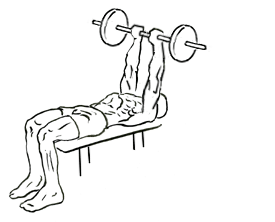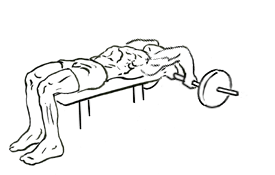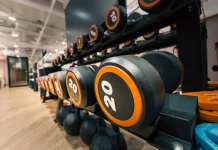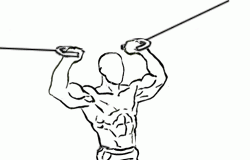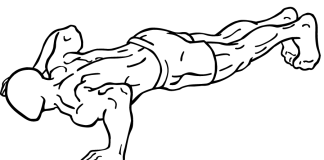Last Updated on September 25, 2014
The Old School Reverse Extension is a classic triceps exercise with a rich history in bodybuilding and strength training. Known for its simplicity and effectiveness, this exercise isolates the triceps, challenging them in a unique way to build strength, definition, and size. Unlike many modern triceps movements, this old-school move relies on traditional form, heavy focus, and controlled motion to deliver results. By lying flat and using an underhand grip, you can deeply engage the triceps and stimulate growth that other exercises may not reach.
In this guide, we’ll dive into the benefits of old school reverse extensions, cover the technique, explore common mistakes, and discuss variations and tips for incorporating this exercise into your triceps routine. Whether you’re new to weightlifting or a seasoned lifter, mastering this movement can help take your arm training to the next level.
Why Old School Reverse Extensions Are Effective
The old school reverse extension effectively isolates and targets the triceps by using an underhand (supinated) grip, which helps activate the triceps differently from exercises like skull crushers or traditional triceps extensions. Here’s why it’s worth adding to your routine:
- Unique Angle and Muscle Engagement: The supinated grip and overhead movement target the triceps from a different angle, helping stimulate the entire triceps, particularly the long head, which contributes to arm size.
- Builds Triceps Strength and Mass: This exercise requires stability and control, helping develop functional strength while increasing triceps size and definition.
- Focuses on Form and Control: Since this exercise is done with a barbell and controlled motion, it emphasizes slow, focused contractions, which maximizes time under tension, a key factor in muscle growth.
- Old-School Simplicity: The exercise’s straightforward nature means you don’t need special equipment—just a barbell and a bench. It’s a versatile movement that’s easy to integrate into any triceps-focused workout.
Anatomy of the Triceps
Understanding the triceps muscle anatomy can help you appreciate the effectiveness of old school reverse extensions:
- Long Head: Located along the back of the arm, the long head is activated during overhead movements, contributing to overall arm size.
- Lateral Head: Positioned on the outer side of the triceps, it contributes to the “horseshoe” shape that is often sought after in bodybuilding.
- Medial Head: Located underneath the long and lateral heads, this head provides stability during pressing and extension movements.
The old school reverse extension primarily targets the long head of the triceps, creating a well-rounded, full look and helping balance the upper arm’s appearance.
Step-by-Step Guide to Performing Old School Reverse Extensions
Step 1: Set Up Your Position
- Select a Flat Bench and Barbell: Place a barbell on the floor or a rack within reach. Use a moderate weight that allows you to focus on form and control.
- Lie Flat on the Bench: Lie down on a flat bench with your head positioned near one end, allowing your arms to extend freely beyond the edge of the bench.
- Grip the Barbell with an Underhand Grip: Grasp the barbell with a supinated (underhand) grip, with your hands about shoulder-width apart. This grip places greater emphasis on the triceps.
Step 2: Position Your Arms and Engage Your Core
- Extend Your Arms Beyond Your Head: Extend your arms fully so that the barbell is positioned slightly above your head, creating a slight stretch in your triceps.
- Keep Your Core Tight: Engage your core and press your back into the bench to maintain stability throughout the movement. Keeping a strong core helps prevent any unnecessary movement and focuses the work on your triceps.
Step 3: Perform the Extension
- Bend Only at the Elbows: Start the movement by bending at the elbows, allowing the barbell to move in an arc down toward the top of your forehead or slightly behind it. Avoid moving your upper arms, as they should remain fixed in place.
- Lower with Control: Continue lowering the barbell in a slow, controlled motion until your forearms reach about a 90-degree angle relative to your upper arms. This controlled descent keeps the focus on the triceps and maximizes muscle engagement.
Step 4: Return to Starting Position
- Press the Barbell Back Up: Extend your elbows to raise the barbell back to the starting position, keeping the movement smooth and controlled.
- Pause and Repeat: Once your arms are fully extended, pause briefly to re-engage the triceps, then continue with the next repetition.
Repeat for the desired number of reps, focusing on maintaining consistent control and form throughout each movement.
Tips for Perfecting Your Form
Form is essential for maximizing the effectiveness of old school reverse extensions while reducing the risk of injury. Here are some tips to help you perform the exercise safely and effectively:
- Keep Upper Arms Fixed: Prevent your upper arms from moving forward or backward. Isolating the triceps is key, so focus on bending only at the elbows.
- Maintain a Slow, Controlled Motion: Avoid using momentum to lift the weight. A slow descent and ascent maximize time under tension and help build strength and muscle.
- Avoid Overextending the Elbows: At the top of each rep, stop just before locking out your elbows. This keeps constant tension on the triceps and prevents strain on the elbow joints.
- Use a Comfortable Grip Width: Start with a shoulder-width grip. Experiment with slight variations in grip width to find what feels most comfortable and effective for engaging your triceps.
Common Mistakes and How to Avoid Them
To get the most out of old school reverse extensions, avoid these common mistakes:
- Using Excessive Weight: Going too heavy compromises form, leading to movement in the shoulders or torso. Start with a moderate weight and prioritize control over load.
- Allowing Elbows to Flare Out: Keep your elbows tucked in and aligned with your shoulders. Flaring the elbows outward reduces triceps activation and increases shoulder strain.
- Bouncing the Weight: Lowering the bar too quickly and then bouncing it back up limits muscle engagement and increases injury risk. Keep the movement controlled and deliberate.
- Arching the Lower Back: Press your back firmly against the bench and engage your core to prevent arching. This ensures the triceps are doing the work, not your lower back.
Variations of Old School Reverse Extensions
Adding variety to this exercise can help challenge the triceps from different angles and prevent muscle adaptation. Here are some effective variations:
1. Single-Arm Reverse Extensions
Perform the movement with one arm at a time, using a lighter dumbbell instead of a barbell. This variation allows you to focus on each tricep independently, helping correct muscle imbalances and enhancing core engagement.
2. Reverse Extensions with EZ Curl Bar
Use an EZ curl bar instead of a straight barbell. The angled grip of the EZ bar can provide a more comfortable wrist position, reducing strain and allowing for greater focus on the triceps.
3. Incline Reverse Extensions
Lie on an incline bench and perform the extension from an angled position. The incline shifts the focus slightly, helping target the long head of the triceps and adding variety to your triceps training.
4. Reverse Extensions with Dumbbells
Using a pair of dumbbells allows for a neutral grip, which can reduce wrist strain and ensure balanced muscle activation on each side. Dumbbells also add a stabilizing component to the exercise, requiring greater control.
5. Cable Reverse Extensions
Attach a bar or rope to a low cable pulley and perform the reverse extension from a standing position. This variation provides constant tension throughout the movement, challenging the triceps in a slightly different way and allowing for a deeper stretch.
Sample Triceps Workout Incorporating Old School Reverse Extensions
Here’s a well-rounded triceps workout that incorporates old school reverse extensions as a central exercise:
- Warm-Up: 5-10 minutes of dynamic stretching, focusing on the shoulders, arms, and core.
- Old School Reverse Extensions: 4 sets of 10-12 reps, focusing on control and form.
- Tricep Pushdowns (Cable): 3 sets of 12-15 reps to target the lateral head of the triceps.
- Skull Crushers (EZ Curl Bar): 3 sets of 10-12 reps for overall tricep strength and mass.
- Overhead Dumbbell Extensions: 3 sets of 10-12 reps to further isolate the long head of the triceps.
- Close-Grip Bench Press: 3 sets of 8-10 reps, combining triceps and chest engagement.
- Cool Down: Light stretching for the triceps, shoulders, and chest to aid recovery.
Safety Tips for Old School Reverse Extensions
Since this exercise involves lowering weight over your head, prioritize safety and proper form:
- Choose a Manageable Weight: Start with a light to moderate weight until you master the movement. Gradually increase the load as your strength improves.
- Use a Spotter if Needed: If you’re lifting heavier, having a spotter can ensure safety, especially if you reach fatigue mid-set.
- Focus on Controlled Breathing: Inhale as you lower the barbell and exhale as you press it back up. Controlled breathing helps stabilize your core and maintain focus.
- Warm Up the Elbows and Shoulders: Before performing old school reverse extensions, it’s essential to warm up the elbow and shoulder joints. Try light arm circles, shoulder mobility drills, and a few lighter tricep exercises to increase blood flow to the area.
- Maintain Wrist Position: Keep your wrists stable and avoid letting them bend backward excessively. Using an underhand grip can sometimes strain the wrists, so keep your grip firm but comfortable, and use an EZ curl bar if needed to relieve pressure.
- Stop if You Feel Pain: While some muscle tension is expected, avoid any sharp or uncomfortable pain in the elbows or shoulders. Pain could indicate improper form or the need to reduce weight.
Progressive Overload Techniques
To continuously build strength and muscle in the triceps, apply progressive overload techniques:
- Increase Weight Gradually: Start with a weight that allows you to maintain perfect form for all reps. As you become stronger, increase the weight by small increments, such as 2.5 to 5 pounds, every few weeks.
- Add Repetitions: Aim to add one or two extra reps to each set once you can complete the current rep range comfortably. This progression helps build endurance and muscle growth over time.
- Slow Down the Tempo: Increase time under tension by slowing down both the lowering (eccentric) and raising (concentric) phases of the movement. Aim for a 3–5 second descent to maximize muscle engagement.
- Pause at the Bottom: Add a slight pause when your elbows are fully bent to further intensify the tricep contraction. This pause creates additional time under tension and strengthens the triceps’ ability to lift from a deep stretch.
- Add Extra Sets: Increase the number of sets once you’ve adapted to your current volume. Adding an additional set can increase the intensity of your triceps workout and promote further muscle growth.
Integrating Old School Reverse Extensions into Different Workouts
The old school reverse extension is highly versatile and can be incorporated into various training styles:
- Upper Body Day: Use it as a primary triceps isolation exercise in a general upper-body workout, pairing it with chest and shoulder exercises.
- Arm Day: Include it alongside other triceps and biceps exercises for a well-rounded arm session.
- Push Day (Push-Pull-Legs Split): Include it in a push-focused workout, where you combine it with chest, shoulder, and additional triceps movements.
- Strength and Hypertrophy Workouts: If your goal is to build muscle size, perform higher reps (10–15) with moderate weight, focusing on a slow, controlled motion for maximum muscle engagement.
Tracking Your Progress
To monitor your improvements and keep pushing forward, record your progress:
- Track Weight and Reps: Record the weight used and the number of reps completed in each workout. Gradually increasing weight or reps indicates strength gains.
- Range of Motion and Control: Note any improvements in range of motion or control over the weight. Being able to control the descent better or add a pause at the bottom can reflect greater strength and muscle endurance.
- Form and Technique: Make notes on your form, such as reduced shoulder involvement or better elbow control. Improved form often translates to better muscle activation.
- Elbow and Wrist Comfort: Take note of any discomfort or strain in the elbows or wrists. Tracking this information can help you determine if you need to adjust your grip, form, or weight.
Frequently Asked Questions (FAQs)
1. How does the old school reverse extension compare to other tricep exercises?
- Unlike exercises like skull crushers or overhead tricep extensions, which use an overhand grip, the reverse extension uses an underhand grip that targets the triceps from a unique angle. This grip can help reduce shoulder strain and focus more on the long head of the triceps.
2. Can beginners do old school reverse extensions?
- Yes, beginners can perform this exercise, but they should start with a light weight (or even a training bar) to focus on form before progressing to heavier loads.
3. What is a good rep range for old school reverse extensions?
- Aim for 10-15 reps per set if you’re focusing on hypertrophy (muscle growth) and 6-10 reps if you’re focusing on building strength.
4. Should I perform old school reverse extensions if I have wrist pain?
- If you experience wrist pain, try using an EZ curl bar instead of a straight barbell, as the angled grip can be more comfortable. Alternatively, use dumbbells to allow a more natural wrist position.
5. How often should I include this exercise in my triceps routine?
- Once or twice a week is typically sufficient, depending on your overall workout split. Allow at least 48 hours of rest between triceps-focused workouts to ensure recovery.
Final Thoughts
The Old School Reverse Extension is a tried-and-true exercise that focuses on building strength, size, and definition in the triceps. With its unique underhand grip and overhead movement, it targets the triceps from a different angle, challenging the muscle while reducing strain on the shoulders. When performed with controlled motion, good form, and progressive overload, this exercise can significantly enhance your arm training routine and help you build strong, well-defined triceps.
Integrate the old school reverse extension into your workouts, focus on steady progress, and make adjustments to the weight and rep range as your strength improves. With dedication and attention to form, this classic tricep movement can become a staple in your training routine, helping you achieve stronger, more sculpted arms.
